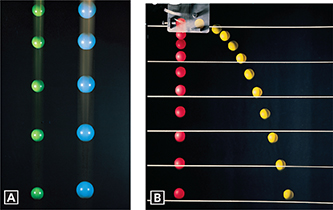Projectile Motion
When you throw a ball forward, you'll notice that it actually follows a curved path. This curved path is an example of projectile motion, the motion of a falling object (projectile) after it is given an initial forward velocity. Air resistance and gravity are the only forces acting on a projectile.
Figure 9 shows the motion of two balls released at the same time. Figure 9A shows that balls of different mass fall at the same rate. In Figure 9B the curved path of the yellow ball is the result of the force of gravity and the initial horizontal velocity.  The combination of an initial forward velocity and the downward vertical force of gravity causes the ball to follow a curved path. The two balls fall with the same acceleration and strike the ground at the same time.
The combination of an initial forward velocity and the downward vertical force of gravity causes the ball to follow a curved path. The two balls fall with the same acceleration and strike the ground at the same time.

Figure 9 Gravity acts on falling objects. A Although their masses are different, the blue and green balls fall at the same rate.
B The yellow ball is a projectile, following a curved path.
Applying Concepts What forces act on each of the falling balls?
Section 12.1 Assessment
Reviewing Concepts
 How is the motion of an object affected when a force acts on it?
How is the motion of an object affected when a force acts on it?List the four types of friction.
 How does air resistance affect the acceleration of a falling object?
How does air resistance affect the acceleration of a falling object? Earth's gravitational force acts in what direction?
Earth's gravitational force acts in what direction? Describe why a projectile follows a curved path.
Describe why a projectile follows a curved path.
Critical Thinking
Comparing and Contrasting Compare the strengths of static, sliding, and rolling friction.
Applying Concepts Explain why falling leaves often do not fall in a straight-line path to the ground.
Predicting Two coins are knocked off a table at the same time by different forces. Which coin will hit the floor first?
Connecting Concepts
Velocity and Acceleration Make sketches of Figures 9A and 9B. Use them to relate the concepts of velocity and acceleration from Section 11.3 to falling objects. Add velocity and acceleration arrows at three locations on each sketch.




